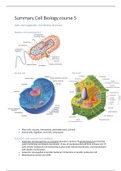Samenvatting
Cell biology course 5 summary
Summary cell biology from course 5 at the HAN. Topics include cell organelles, membrane and structures, cytoskeleton, extracellular matrix, cell cycle, meiosis, mitosis, membrane transport, intracellular compartments, protein transport, cell signaling,
[Meer zien]





